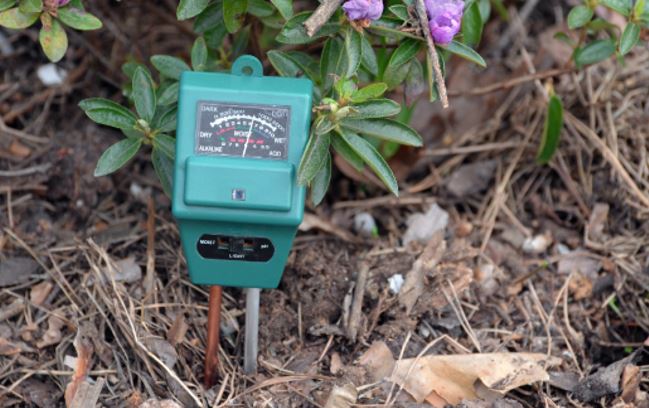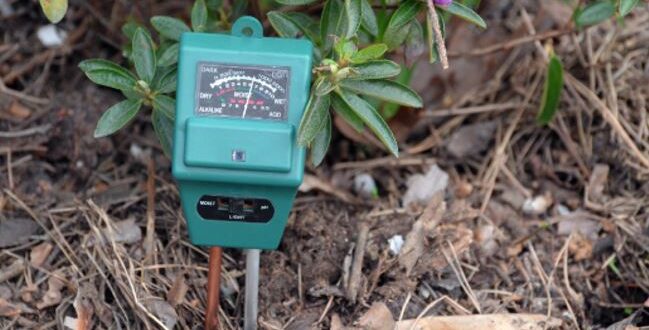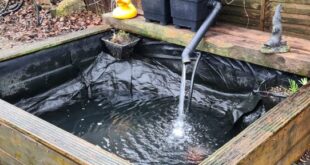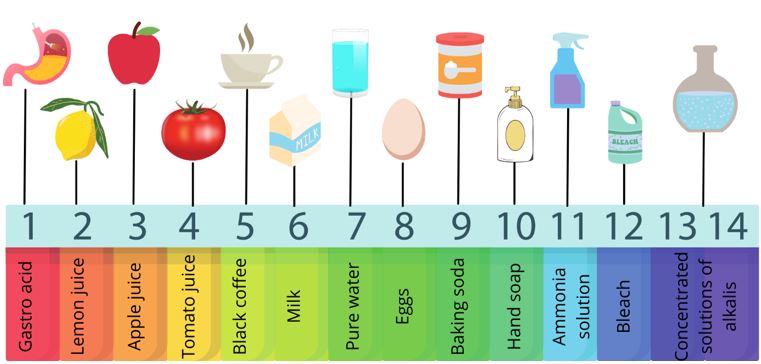Soil pH is an overlooked factor by many gardeners. You may not realise that soil acidity affects how well your plants thrive. If this is something new to you, you may want to continue reading. In our guide to soil acidity, you’ll find out what it is, how it’s important, and what you can do about it.
What is soil pH?
Soil pH or acidity is a measure to determine how acidic your soil is. pH is measured on a scale of 1 to 14, with 1 being acidic and 14 being alkaline. A pH of 7 is neutral. The pH scale is a logarithmic scale, which provides numerical data across a broad range on a concise scale.
Lower scores of pH indicate the strength of acidity, with lower scores indicating greater strength. Higher scores of pH indicate the strength of alkaline with higher scores indicating greater strength. The same applies to your soil.
The measure of pH in your soil determines the hydrogen ion concentration. It is the concentration of hydrogen ions that influences your acidity. The greater concentration of hydrogen ions, the more acidic your soil will be and vice versa.
You may already be familiar with the pH scale, which measures acidic as red and alkaline as purple. The same is true for your soil. You can have different measures of acidity. This may not be something you have even considered before, but it can make a difference in growing plants.
Here is the pH scale to give you an idea:
Soil pH in the UK
In the UK, most soils will be within the neutral area of the pH scale. The type of soil can also be a significant factor. Soils that sit on bedrocks of limestone or chalk will be alkaline. Conversely, heathlands and coniferous woodlands will have acidic soil.
Areas such as the Yorkshire Wolds, Chiltern Hills, and Salisbury Plain, alongside the North and South Downs, will have acidic soil. The Yorkshire Dales, Brecon Beacons, and Dartmoor National surrounding areas will have acidic soil.
Clay soil and sandy soils will by a neutral pH, giving you much more flexibility to grow a broad range of plants without any acidity issues. However, a golden tip to consider is that you should pick plants that suit your soil pH as opposed to changing your soil acidity to suit the plants you choose.
Why is soil pH important?
Nutrient Absorption
The biggest reason why you should consider monitoring your soil acidity is that it can affect how well plants grow. Typically, maintaining a healthy pH level can ensure a healthy garden. That’s not to say that having your soil at a pH not ideally suited to your plants will kill them.
Instead, an incorrect soil pH can prevent or slow down growth. That’s because the acidic level determines the amount of nutrients your plants can absorb from the soil. Soil at an ideal acidity for your plants will help them absorb more nutrients.
If you want to ensure that the nutrients in the soil are soluble for plants, you should maintain a healthy pH level. Otherwise, nutrients become insoluble in water for plants. Here is a graphic to showcase the nutrients available for plants at different soil acidity levels.
Find out more about the ideal pH level for different vegetables, fruits, and flowers.
For those who want to grow hydrangeas, here’s a little tip. The colour of your hydrangea will change depending on soil acidity. Alkaline soil leads to blue-coloured flowers, while acidic soil will lead to red-coloured flowers. You can also change the colour by altering your soil acidity.
All the essential nutrients that plants require can be readily available if your soil maintains a neutral pH level. Of the 17 nutrients plants require for growth, 14 are obtained through the soil. That’s why it’s important to maintain the right acidity level for your soil.
Microorganisms
Another reason why soil acidity is important is that it affects the microorganisms in the soil. Microorganisms are important as they provide a diverse biosystem that decomposes organic matter. Soil that is too acidic will affect bacteria in the soil and reduce their ability to decompose matter.
The microorganisms that are found in soil (such as fungi, bacteria, and archaea) are all essential to promoting growth for your plants. Without the microorganisms in the soil, plants would lack a vital food source.
In some cases, beneficial microbes in the soil can also help a plant survive in the event of nutrient imbalance and drought. In acidic soil, the growth and reproduction of soil microbes, however, are reduced. In this event, organic matter is not broken down as efficiently or effectively.
What affects soil acidity?
Many different factors can influence the acidity of your soil. In most cases, normal garden processes will alter the acidity level of soil without you even realising it. While the rocks that form your soil will be the biggest factor, these other factors also play a part:
- Plant growth
- Water flow
- Acid rain
- Fertiliser
- Adding minerals to the soil
- Root respiration
In most cases, a healthy garden will have a pH score between 6 and 8. However, most gardens will have soil acidity between 5 and 8. Soil acidity will also change from plant to plant so it’s important to check. If you don’t know the pH level of soil, there are a few ways you can check it.
How do you measure soil acidity?
No matter the size of your garden or the number of plants you grow, paying careful attention to soil pH is important. While it is good for plants already in the ground, it’s even more so important before planting new plants.
If you’ve noticed your plant foliage turning yellow or are disappointed by how well a plant has grown, now is a good time to measure your soil pH level. It’s important to be aware that if you have added any fertiliser to your garden in the last 3 months, you will not receive accurate results.
Using a meter

The quickest and easiest way you can check your soil acidity levels is by using a soil pH meter. These small handy devices provide accurate readings straight away. They can be used over and over again, making them ideal for measuring soil acidity over long periods.
A convenient device for any gardener, all you need to do is stick the probes into the ground and switch the device on. No soil samples, water, or testing solution is required. Depending on the meter, you may also be provided with moisture and light readings too.
Some meters work through solar power meaning no power supply or batteries are needed. Not only does it provide a quick way for measuring soil acidity, but it’s also better for the environment too! Just remember to clean the probes after use to prevent the spread of diseases.
pH test kits
Another method you can use to measure soil acidity is using a test kit. These kits are designed to give you a rough estimate of soil acidity. Unlike a pH meter, a test kit doesn’t give you precise readings. Instead, you use a bit of chemistry.
A test kit will usually come with a test tube, testing solution and a pH chart. Firstly, you need to collect a small clean soil sample that is free from any debris (such as broken twigs or stones). Place the soil sample into the test tube.
An ideal soil sample will be taken from around 6-8 inches below the surface. Add the required amount of testing solution into the test tube with your soil sample. Give the solution a bit of a shake and wait for the liquid to clear.
Depending on the concentration of hydrogen ions, the solution will change colour. If the solution turns red, you have acidic soil. If the solution turns purple, you have alkaline soil. You can try matching the strength of the colour with the chart for a better estimation of acidity.
Litmus paper
Similar to the test kit, you can also use litmus paper to get a rough idea of soil acidity. Litmus paper is designed specifically for changing colour depending on the acidity of the liquid. It works similarly to the testing solution from a test kit.
Using a clean soil sample, taken 6-8 inches below the surface that’s free of any debris, you can get a rough estimation of your soil pH level. Mix the soil sample with water. Tap water will suffice. Then, after mixing, dip the litmus paper into the solution. Wait for the paper to change colour and voila!
How do you alter your soil acidity?
After testing the pH level of the soil, you may discover you need to alter the acidity. If so, there are a few easy and handy ways you can do this.
Making soil more acidic
If you want to increase the acidic strength of soil, the most popular method you can use to make the soil acidic is adding sulphur. You can use either chips or powder solutions depending on how quickly you want to change pH. The finer the powder, the quicker the change in acidity.
Sulphur is the best way to make the soil more acidic without causing harm to your plants. A fertiliser with sulphur can also help make the soil more acidic. Aluminium is also another choice that makes the soil more acidic once dissolved. This can work almost instantly.
Making soil more alkaline
If you want to tone down the acidic level of soil and make it more alkaline, there are also some other handy solutions you can mix into the soil. The best way to make the soil more alkaline is by adding lime or dolomite.
The amount you need to add will depend on the level you wish to change your pH alongside the type of soil you have. For example, clay soils will require a lot more lime or dolomite to change the acidity due to the slow drainage of this soil type.
Not all plants are suited to the addition of lime though. Camellias and rhododendrons don’t like lime. In this case, adding wood ash may be a worthwhile solution. Adding wood ash can provide you would with potassium and calcium nutrients that help increase alkaline levels.
You could also consider using a nitrate-based fertiliser too that can help increase the alkaline level of the soil.
We hope from our guide that you now have a much better understanding of how the pH level can affect your garden. By using the different test methods, you can find out which plants would be better suited to your garden. With tips for changing the pH level, you can maintain a healthy garden.
 Gardeners Club The Gardeners Club is a free to join online club for everyone with an interest in gardening and gardens.
Gardeners Club The Gardeners Club is a free to join online club for everyone with an interest in gardening and gardens.







